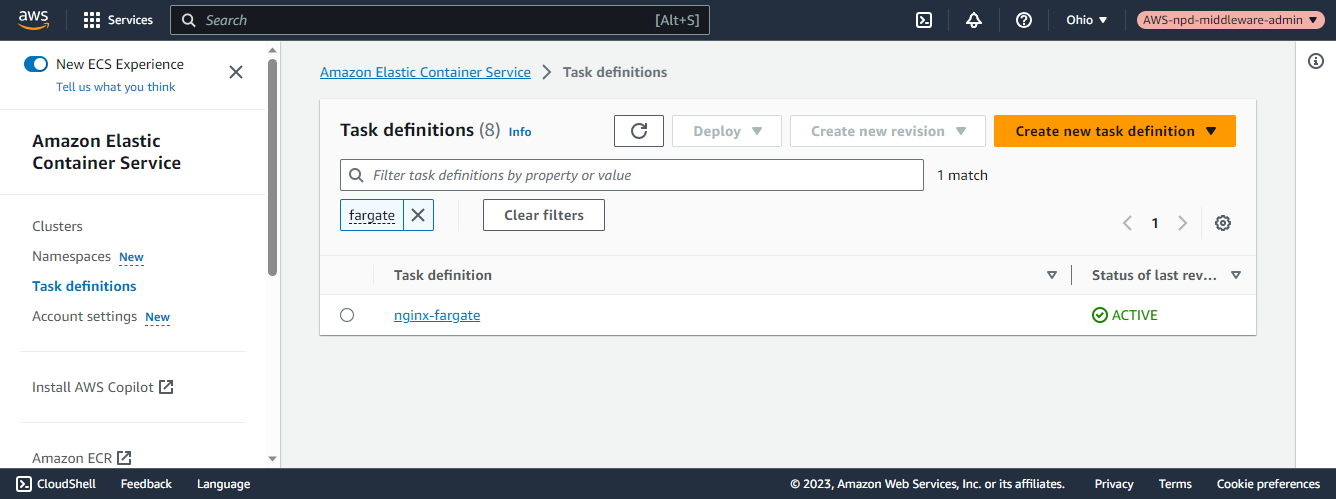
Let's say you have the following files on your Terraform server.
├── required_providers.tf
├── elastic_container_services (directory)
│ ├── task_defintions (directory)
│ ├── ├── fargate (directory)
│ ├── ├── ├── provider.tf
│ ├── ├── ├── task_definition.tf
required_providers.tf will almost always have this.
terraform {
required_providers {
aws = {
source = "hashicorp/aws"
}
}
}
Let's say provider.tf has the following. In this example, the "default" profile in /home/username/.aws/config and /home/username/.aws/credentials is being used. This assumes you have setup Terraform as described in Amazon Web Services (AWS) - Getting Started with Terraform.
provider "aws" {
alias = "default"
profile = "default"
region = "default"
}
This assumes you have already Created an Elastic Container Service (ECS) Cluster using Terraform.
An ECS deployment can be:
- EC2 - apps run in EC2 instance
- FARGATE - serverless (no EC2 instances)
task_definitions.tf could have something like this where requires_compatibilities is FARGATE.
resource "aws_ecs_task_definition" "flask-fargate-task-definition" {
family = "flask"
network_mode = "awsvpc"
requires_compatibilities = ["FARGATE"]
cpu = 1024
memory = 2048
container_definitions = jsonencode([
{
name = "flask-container"
cpu = 10
memory = 512
image: "tiangolo/uwsgi-nginx-flask:python3.11",
portMappings: [
{
containerPort: 3000,
hostPort: 3000
}
]
}
])
}
You may need to reissue the terraform init command.
~]# terraform init
Initializing the backend...
Initializing modules...
Initializing provider plugins...
Terraform has been successfully initialized!
The terraform plan command can be used to see what Terraform will try to do.
~]$ terraform plan
Terraform will perform the following actions:
# aws_ecs_task_definition.flask-fargate-task-definition will be created
+ resource "aws_ecs_task_definition" "flask-fargate-task-definition" {
+ arn = (known after apply)
+ arn_without_revision = (known after apply)
+ container_definitions = jsonencode(
[
+ {
+ cpu = 10
+ image = "tiangolo/uwsgi-nginx-flask:python3.11"
+ memory = 512
+ name = "flask"
+ portMappings = [
+ {
+ containerPort = 80
+ hostPort = 80
},
]
},
]
)
+ cpu = "1024"
+ family = "flask"
+ id = (known after apply)
+ memory = "2048"
+ network_mode = "awsvpc"
+ requires_compatibilities = [
+ "EC2",
]
+ revision = (known after apply)
+ skip_destroy = false
+ tags_all = (known after apply)
}
Plan: 1 to add, 0 to change, 0 to destroy.
The terraform apply command can be used to create, update or delete the resource.
terraform apply -auto-approve
The aws ecs list-task-definitions command can be used to list the ECS Task Definitions that have been created. Something like this should be returned.
~]$ aws ecs list-task-definitions
{
"taskDefinitionArns": [
"arn:aws:ecs:us-east-1:123456789012:task-definition/my-task-definition:1",
"arn:aws:ecs:us-east-1:123456789012:task-definition/my-task-definition:2"
]
}
And the Task Definition should be listed in the AWS ECS console.

Did you find this article helpful?
If so, consider buying me a coffee over at 